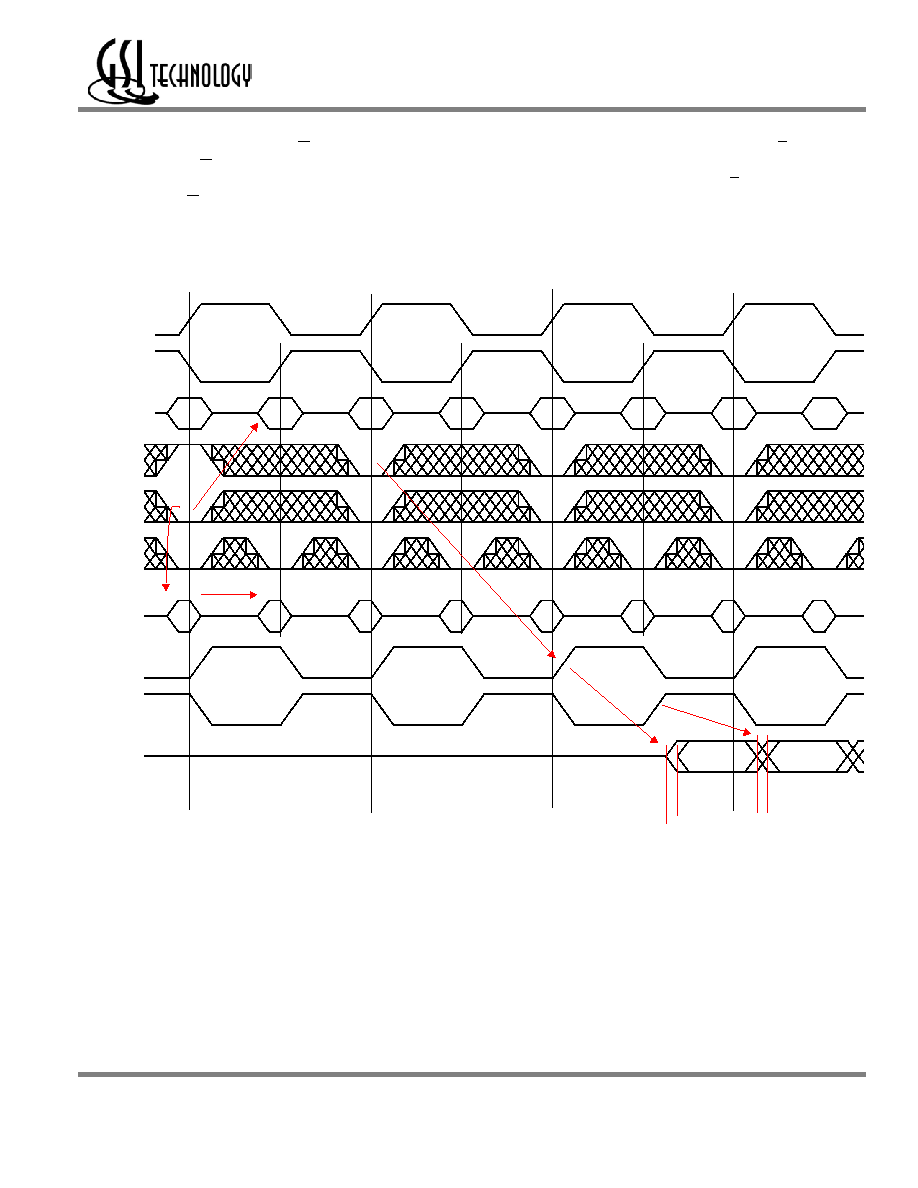
Rev: 1.00 6/2003
1/26
Specifications cited are design targets and are subject to change without notice. For latest documentation contact your GSI representative.
Preliminary
GS890QV18D-200/167/133/100
9Mb
2x2B2
SigmaQuad SRAM
100 MHz≠200 MHz
2.5 V V
DD
1.8 V and 1.5 V I/O
165-Bump BGA
Commercial Temp
Industrial Temp
Features
∑ Simultaneous Read and Write SigmaQuadTM Interface
∑ JEDEC-standard pinout and package
∑ Dual DoubleData Rate interface
∑ Byte Write controls sampled at data-in time
∑ Burst of 2 Read and Write
∑ 2.5 V +100/≠100 mV core power supply
∑ 1.5 V or 1.8 V HSTL Interface
∑ Pipelined read operation
∑ Fully coherent read and write pipelines
∑ ZQ mode pin for programmable output drive strength
∑ IEEE 1149.1 JTAG-compliant Boundary Scan
∑ 165-bump, 13 mm x 15 mm, 1 mm bump pitch BGA package
∑ Pin-compatible with future 18Mb, 36Mb, 72Mb, and 144Mb devices
SigmaRAMTM Family Overview
GS890QV18 are built in compliance with the SigmaQuad SRAM
pinout standard for Separate I/O synchronous SRAMs. They are
9,437,184-bit (9Mb) SRAMs. These are the first in a family of wide,
very low voltage HSTL I/O SRAMs designed to operate at the speeds
needed to implement economical high performance networking
systems.
Clocking and Addressing Schemes
A
2x2B2 SigmaQuad SRAM is a synchronous device. It employs
two input register clock inputs, K and K. K and K are independent
single-ended clock inputs, not differential inputs to a single differential
clock input buffer. The device also allows the user to manipulate the
output register clock inputs quasi independently with the C and C
clock inputs. C and C are also independent single-ended clock inputs,
not differential inputs. If the C clocks are tied high, the K clocks are
routed internally to fire the output registers instead.
Because Separate I/O
2x2B2
RAMs always transfer data in two
packets, A0 is internally set to 0 for the first read or write transfer, and
automatically incremented by 1 for the next transfer. Because the LSB
is tied off internally, the address field of a
2x2B2
RAM is always one
address pin less than the advertised index depth (e.g., the 512K x 18
has a 256K addressable index).
Alternating Read-Write Operations
SigmaQuad SRAMs follow a few simple rules of operation.
- Read or Write commands issued on one port are never allowed to
interrupt an operation in progress on the other port.
- Read or Write data transfers in progress may not be interrupted and
re-started.
- R and W high always deselects the RAM.
- All address, data, and control inputs are sampled on clock edges.
In order to enforce these rules, each RAM combines present state
information with command inputs. See the Truth Table on page 10
for details.
-200
-167
-133
-100
tKHKH
5.0 ns
6.0 ns
7.5 ns
10.0 ns
tKHQV
2.3 ns
2.4 ns
3.0 ns
3.0 ns
165-Bump, 13 mm x 15 mm BGA
1 mm Bump Pitch, 11 x 15 Bump Array
Bottom View
JEDEC Std. MO-216, Variation CAB-1

Rev: 1.00 6/2003
2/26
Specifications cited are design targets and are subject to change without notice. For latest documentation contact your GSI representative.
Preliminary
GS890QV18D-200/167/133/100
1M x 18 SigmaQuad SRAM -- Top View
1
2
3
4
5
6
7
8
9
10
11
A NC
V
SS
/SA
(144Mb)
NC/SA
(36Mb)
W
BW1
K
NC
R
NC/SA
(18Mb)
V
SS
/SA
(72Mb)
NC
B NC
Q9
D9
SA
NC
K
BW0
SA
NC
NC
Q8
C NC
NC
D10
V
SS
SA
SA
SA
V
SS
NC
Q7
D8
D NC
D11
Q10
V
SS
V
SS
V
SS
V
SS
V
SS
NC
NC
D7
E NC
NC
Q11
V
DDQ
V
SS
V
SS
V
SS
V
DDQ
NC
D6
Q6
F
NC
Q12
D12
V
DDQ
V
DD
V
SS
V
DD
V
DDQ
NC
NC
Q5
G NC
D13
Q13
V
DDQ
V
DD
V
SS
V
DD
V
DDQ
NC
NC
D5
H NC
V
REF
V
DDQ
V
DDQ
V
DD
V
SS
V
DD
V
DDQ
V
DDQ
V
REF
ZQ
J NC
NC
D14
V
DDQ
V
DD
V
SS
V
DD
V
DDQ
NC
Q4
D4
K NC
NC
Q14
V
DDQ
V
DD
V
SS
V
DD
V
DDQ
NC
D3
Q3
L NC
Q15
D15
V
DDQ
V
SS
V
SS
V
SS
V
DDQ
NC
NC
Q2
M NC
NC
D16
V
SS
V
SS
V
SS
V
SS
V
SS
NC
Q1
D2
N NC
D17
Q16
V
SS
SA
SA
SA
V
SS
NC
NC
D1
P NC
NC
Q17
SA
SA
C
SA
SA
NC
D0
Q0
R TDO
TCK
SA
SA
SA
C
SA
SA
SA
TMS
TDI
11 x 15 Bump BGA--13 x 15 mm2 Body--1 mm Bump Pitch
Notes:
1. Expansion addresses: A3 for 36Mb, A10 for 72Mb, A2 for 144Mb
2. BW0 controls writes to D0:D8. BW1 controls writes to D9:D17.
3. MCL = Must Connect Low
4. It is recommended that H1 be tied low for compatibility with future devices.

Rev: 1.00 6/2003
3/26
Specifications cited are design targets and are subject to change without notice. For latest documentation contact your GSI representative.
Preliminary
GS890QV18D-200/167/133/100
Note: NC = Not Connected to die or any other pin
Background
Separate I/O SRAMs, from a system architecture point of view, are attractive in applications where alternating reads and writes are needed.
Therefore, the SigmaQuad SRAM interface and truth table are optimized for alternating reads and writes. Separate I/O SRAMs are unpopular in
applications where multiple reads or multiple writes are needed because burst read or write transfers from Separate I/O SRAMs can cut the
RAM's bandwidth in half.
A SigmaQuad SRAM can begin an alternating sequence of reads and writes with either a read or a write. In order for any separate I/O SRAM that
shares a common address between its two ports to keep both ports running all the time, the RAM must implement some sort of burst transfer
protocol. The burst must be at least long enough to cover the time the opposite port is receiving instructions on what to do next. The rate at which
a RAM can accept a new random address is the most fundamental performance metric for the RAM. Each of the three SigmaQuad SRAMs
support similar address rates because random address rate is determined by the internal performance of the RAM and they are all based on the
same internal circuits. Differences between the truth tables of the different SigmaQuad SRAMs, or any other Separate I/O SRAMs, follow from
differences in how the RAM's interface is contrived to interact with the rest of the system. Each mode of operation has its own advantages and
disadvantages. The user should consider the nature of the work to be done by the RAM to evaluate which version is best suited to the application
at hand.
Pin Description Table
Symbol
Description
Type
Comments
SA
Synchronous Address Inputs
Input
--
NC
No Connect
--
--
R
Synchronous Read
Input
Active Low
W
Synchronous Write
Input
Active Low
BW0≠BW1
Synchronous Byte Writes
Input
Active Low
K
Input Clock
Input
Active High
K
Input Clock
Input
Active Low
C
Output Clock
Input
Active High
C
Output Clock
Input
Active Low
TMS
Test Mode Select
Input
--
TDI
Test Data Input
Input
--
TCK
Test Clock Input
Input
--
TDO
Test Data Output
Output
--
V
REF
HSTL Input Reference Voltage
Input
--
ZQ
Output Impedance Matching Input
Input
--
D0≠D17
Synchronous Data Inputs
Input
--
Q0≠Q17
Synchronous Data Outputs
Output
--
V
DD
Power Supply
Supply
2.5 V Nominal
V
DDQ
Isolated Output Buffer Supply
Supply
1.5 V Nominal
V
SS
Power Supply: Ground
Supply
--

Rev: 1.00 6/2003
4/26
Specifications cited are design targets and are subject to change without notice. For latest documentation contact your GSI representative.
Preliminary
GS890QV18D-200/167/133/100
2x2B2 SigmaQuad SRAM DDR Read
The read port samples the status of the Address Input and R pins at each rising edge of K. A low on the Read Enable-bar pin, R, begins a read
cycle. Data can be clocked out one cycle later and again one half cycle after that. A high on the Read Enable-bar pin, R, begins a read port
deselect cycle.
2x2B2 Double Data Rate SigmaQuad SRAM Read First
Dwg Rev. G
DC0
DC1
DE0
DE1
DG0
DG1
QB0
QB1
E
No Op
Read
Write
Read
Write
XX
K
/K
Address
XX
B
C
D
No Op
C
/C
D
Q
/R
/W
/BWx
Write
Read
G
F

Rev: 1.00 6/2003
5/26
Specifications cited are design targets and are subject to change without notice. For latest documentation contact your GSI representative.
Preliminary
GS890QV18D-200/167/133/100
2x2B2 SigmaQuad SRAM DDR Write
The write port samples the status of the W pin at each rising edge of K and the Address Input pins on the following rising edge of K. A low on the
Write Enable-bar pin, W, begins a write cycle. The first of the data-in pairs associated with the write command is clocked in with the same rising
edge of K used to capture the write command. The second of the two data in transfers is captured on the rising edge of K along with the write
address. A high on W causes a write port deselect cycle.
2x2B2 Double Data Rate SigmaQuad SRAM Write First
Dwg Rev. G
DB0
DB1
DD0
DD1
DF0
DF1
DH0
DH1
/C
K
/K
D
Q
Read
Write
Address
XX
B
C
D
E
F
No Op
Write
Read
Write
C
/R
/W
/BWx
Write
Read
H
QC0
QC1
G




